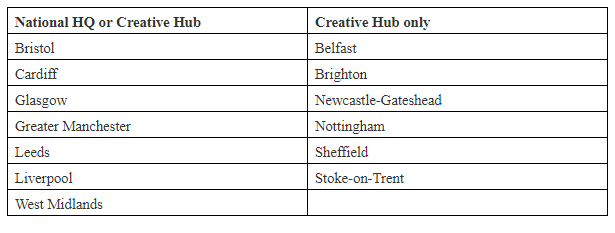
Relocation, Relocation, Relocation: the story of Channel 4’s move away from London
As you probably know, Channel 4 is on the move, slicing its London headquarters and moving hundreds of key jobs beyond the capital and creating various “hubs” in the process.
But what’s the full story?
And why is the move even happening?
Here’s how it’s unfolded:
In the beginning...
Channel 4 launched on 2 November 1982 with a “revolutionary business model” – funded by advertising but owned by taxpayers – which enabled all profits to go back into programmes made by hundreds of production companies up and down the country.
So what’s happened?
The Telegraph reported in February 2018 that Channel 4 was under pressure from the government to relocate its headquarters away from London, and the Department for Culture, Media and Sport wanted the matter resolved in “weeks not months”.
Why the government pressure?
That followed former Culture Secretary Karen Bradley’s decision, after a major review, to rule out privatisation of the broadcaster. New laws were drafted should Channel 4 have decided not to move voluntarily.
Channel 4 launches ‘4 All the UK’
In March 2018, Channel 4 launched ‘4 all the UK’, a plan to “provide a significant boost to investment and jobs in the nations and regions and ensure that we do even more to serve the whole of the UK”.
A key part of the plan, described by the broadcaster as “the biggest revolution of our business”, is to create a new national HQ and two creative hubs in the nations and regions. The pitch brochure is here.
Channel 4 will:
- Spend £250 million more in commissioning programmes from across the UK (resulting from an increase in content spend from its current quota of 35 per cent to a new voluntary target of 50 per cent by 2023). It currently spends £169m annually
- Launch three brand-new “hubs” in three different parts of the UK, the largest of these being “a major physical presence”, to be known as known as Channel 4’s national HQ (Horseferry Road will remain Channel 4’s London HQ)
- Move 300 jobs – including “key creative decision makers” – to the nations and regions (Channel 4 currently employs about 30 staff outside London)
- Reduce their London-based operation, making freed space available to “independent producers and creative companies from the nations and regions”
- Open more Channel 4 news bureaux outside London, including a new hub studio in the nations and regions
- Expect their “revolution” to support up to 3,000 new jobs outside London
- Not leave London completely because, according to the broadcaster’s former chief executive David Abraham, it’d cripple its business as “up to 80 per cent of its workforce would quit if they were forced to move out of the capital”
The process
With the plan launched, Channel 4 invited pitches in April from cities across the UK to host its new national HQ and creative hubs. More than 30 submissions were received in this first round.
And in May, shortlisted contenders were selected to participate in the second stage of the pitch process. Seven cities were shortlisted for consideration as a national HQ or creative hub, and a further six for consideration as a creative hub only.
The shortlist was as follows:

This was whittled down in July to a total of six cities:

The winning cities – and the biggest change to Channel 4’s structure in its 35-year history – will be announced in October 2018.
What else is on the horizon for Channel 4?
In the May edition of In The Frame…, Frame 25’s monthly round-up of industry news, we included a line about Channel 4’s talks with the BBC and ITV to create a new streaming service.
Next month, we’ll look at that in more detail as well as a wider view of the UK’s public service broadcasters (PSBs) and their future, as they take on the might of Netflix and the other major OTT offerings.

Product + audience + platform: why the Premier League is going its own way

In The Frame - April '23
